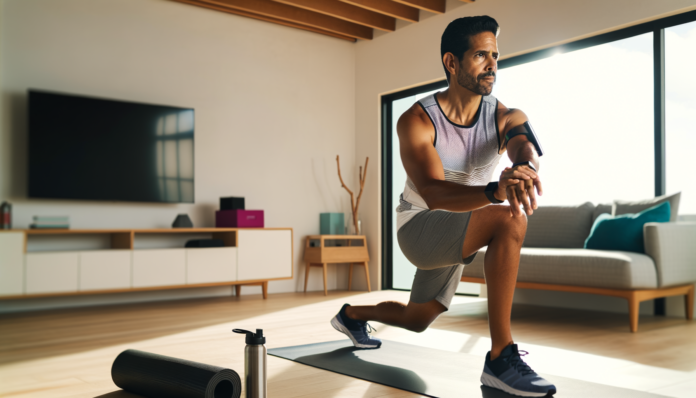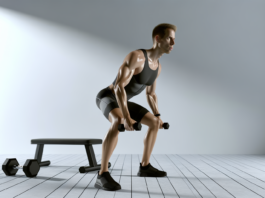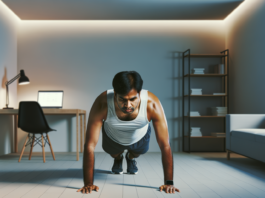Introduction to Flexibility and Its Importance
Understanding Flexibility
Flexibility refers to the range of motion available around a joint or series of joints, and the length in muscles that cross the joints to induce a bending movement or motion. Flexibility is an essential component of physical fitness and involves the ability of muscles and tendons to stretch and adapt to changes in movement and positioning. It is a key factor in performing daily activities with ease, participating in sports, and preventing injury.
Benefits of Flexibility for Men
For men, maintaining flexibility is crucial for a variety of reasons. It enhances performance in physical activities, reduces the risk of injuries, improves posture and balance, and can alleviate muscle tension and soreness. Flexible muscles can also aid in the recovery process after workouts, helping to reduce the likelihood of muscle cramps and stiffness. Moreover, flexibility training can contribute to better overall health by improving circulation and reducing stress levels.
The Role of Flexibility in Fitness and Health
Flexibility plays a significant role in overall fitness and health. It allows for greater freedom of movement and improved physical capabilities. A lack of flexibility can lead to decreased mobility, which can result in a higher risk of strains, sprains, and muscular damage. Regular stretching is vital to keep muscles long, lean, and flexible, ensuring that exertion does not put too much force on the muscle itself. This balance helps to maintain a healthy range of motion in the joints and supports the body’s natural ability to move and function optimally.
Common Flexibility Myths Debunked
There are several myths surrounding flexibility that can deter men from incorporating it into their fitness routine. One common misconception is that flexibility is only necessary for athletes or those involved in activities like gymnastics or dance. However, flexibility is important for everyone, regardless of their level of physical activity. Another myth is that stretching before muscles are warmed up is beneficial, but research suggests that cold muscles may be more prone to injury when stretched. It’s recommended to warm up with light activity before stretching. Lastly, some believe that achieving flexibility is an overnight process, when in reality, it requires consistent effort over time to maintain and improve.
Assessing Your Flexibility
Why You Should Assess Your Flexibility
Flexibility is a critical component of overall fitness, impacting your ability to perform daily activities with ease, participate in sports, and maintain your independence as you age. Assessing your flexibility can provide a baseline to help you understand your current range of motion, identify any imbalances or areas of tightness, and set informed goals for improvement. Regular assessments can also track your progress, keeping you motivated and alert to any changes that may require attention.
Simple Tests to Measure Flexibility
To begin assessing your flexibility, you can perform simple tests that target key muscle groups. One common test is the sit-and-reach, which evaluates the flexibility of your hamstrings and lower back. To perform this test, sit on the floor with your legs extended in front of you and reach forward as far as possible while keeping your knees straight. The distance between your fingertips and your toes is a measure of your flexibility.
Another test is the shoulder flexibility test, where you reach one arm over your shoulder and the other up your back to see how close your hands can come to touching. This test assesses the flexibility of your shoulders and upper back.
For the lower body, the knee-to-chest test can help gauge the flexibility of your hip flexors. Lying on your back, pull one knee to your chest while keeping the other leg straight on the ground. The ease with which you can pull your knee to your chest and the angle formed by your thigh and torso provide insight into your hip flexibility.
Setting Realistic Flexibility Goals
Once you’ve assessed your flexibility, it’s important to set realistic and achievable goals. If you find that your flexibility is lacking in certain areas, aim to improve gradually. For example, if you’re unable to touch your toes in the sit-and-reach test, set a goal to reach an inch closer each week.
Remember that flexibility improvements take time and consistency. It’s not uncommon for significant changes to take weeks or even months. Set short-term goals that lead to a long-term objective, and celebrate the small victories along the way. This approach not only keeps you motivated but also helps prevent injury by avoiding overstretching and pushing your body too far, too fast.
Lastly, consider your lifestyle, age, and any pre-existing conditions when setting your goals. Flexibility naturally decreases with age, and certain medical conditions may affect your range of motion. Always consult with a healthcare professional or a certified fitness trainer if you have concerns or need guidance tailored to your specific needs.
Daily Flexibility Routines
Morning Stretching Routine
Starting your day with a stretching routine can awaken your body and increase blood flow. A five-minute morning stretch can include:
- Spinal Twists: Sit on the floor with legs crossed, twist gently to each side, holding for 30 seconds.
- Standing Hamstring Stretch: Stand and reach towards your toes, keeping legs straight, hold for 30 seconds.
- Chest Opening Stretch: Stand in a doorway, place forearms on the frame, and lean forward for 30 seconds.
Midday Movement Breaks
Midday stretches can combat the stiffness from sitting. A quick midday movement routine could be:
- Head and Shoulder Rolls: Roll your head and shoulders in both directions for 30 seconds each.
- Triceps Stretch: Reach one arm across your body, use the other to press gently towards your chest, hold for 30 seconds each side.
- Standing Quad Stretch: Bend one leg back, hold your foot, and press your hip forward, hold for 30 seconds each side.
Evening Wind-Down Stretches
Evening stretches can help you unwind and prepare for sleep. A relaxing evening routine might include:
- Child’s Pose: Sit back on your heels with arms extended, hold for 30 seconds to 1 minute.
- Figure Four Stretch: Lie on your back, cross one ankle over the opposite knee, and pull gently, hold for 30 seconds each side.
- Kneeling Hip Flexor Stretch: Kneel and step one foot forward, tilt your pelvis up, hold for 30 seconds each side.
Pre- and Post-Workout Stretching
Stretching around workouts is crucial for performance and recovery. Dynamic stretches are recommended before workouts to warm up muscles, such as leg swings and arm circles. After exercising, static stretches help cool down and maintain flexibility. Focus on areas worked during your session, holding each stretch for up to 30 seconds.
- Post-Run: Stretch calves, hamstrings, and quads.
- After Weightlifting: Target the muscle groups you’ve worked with stretches like the chest fly stretch or a seated forward bend for the lower back and hamstrings.
Remember, stretches should feel good and never painful. Consistency is key to improving flexibility, so incorporate these routines daily for the best results.
Flexibility Exercises for Key Muscle Groups
Upper Body Stretches
For men who spend a significant amount of time at a desk or in front of a computer, upper body flexibility is crucial to prevent tightness and maintain good posture. Chest and shoulder stretches are particularly beneficial. To perform a simple chest stretch, stand in the middle of an open doorway and place your forearms on each side of the doorframe. Gently lean forward until you feel a stretch through the front of your chest and shoulders. Hold for 30 seconds, ensuring you do not push to the point of pain. This stretch targets the chest, anterior deltoid, and biceps muscles.
Another effective upper body stretch is the Overhead Reach Stretch. Stand with your feet shoulder-width apart and extend your arms toward the ceiling as high as you can, lifting your face skyward to feel a stretch in your neck and chest. This can be followed by the Diagonal Reach Stretch, where you drop one shoulder and reach the opposite arm toward the sky, feeling a stretch down the side of your body. Hold each stretch for 30 seconds and repeat on the other side.
Core and Back Stretches
The core and back are integral to overall flexibility and strength. A tight lower back can lead to discomfort and limit mobility. To stretch this area, try the Spinal Twist. Sit on the floor with legs crossed, and gently twist your shoulders to one side, using your arm for leverage. Hold for 30 seconds and repeat on the other side, targeting the erector spinae, glutes, and low back.
For the core, the Butterfly Stretch is excellent for the inner thighs and hips. Sit with the soles of your feet touching and knees dropped to the sides. Lean forward with a flat back, bringing your head towards your feet as far as comfortable. Hold for 30 seconds, focusing on the adductors and hip flexors.
Lower Body Stretches
Lower body flexibility is essential for daily movements such as walking, squatting, and bending. The Hamstring Hinge Stretch is a fundamental exercise that targets the hamstrings and can alleviate lower back pain. Stand with your feet shoulder-width apart, hinge at the waist, and reach your hands toward the floor. Hold for 30 seconds, feeling the stretch in the back of your legs.
The Standing Quad Stretch is another key stretch for the lower body. Stand near a wall for balance, bend one knee, and pull your foot towards your buttocks, keeping your knees together and hips forward. This stretch works the quadriceps and should be held for 30 seconds on each side.
Lastly, the Iliotibial Band Stretch is crucial for those who engage in activities like running or cycling. Cross one leg over the other and stretch the opposite arm over your head, bending at the waist to the side. This targets the IT band and should be held for 30 seconds before switching sides.
Incorporating these stretches into your daily routine can significantly improve flexibility and mobility across all major muscle groups. Remember to breathe deeply during each stretch and never force a movement into pain. Consistency is key to seeing improvements in flexibility and preventing injury.
Incorporating Flexibility Training into a Busy Schedule
Time-Saving Stretching Techniques
For the active man, finding time for a full stretching routine can be challenging. However, flexibility can be improved with short, focused sessions. Static stretches are a time-efficient method, requiring as little as 5 to 10 minutes at the start or end of your day. These can include hamstring stretches, chest openers, or spinal twists. Another approach is active stretching, which involves using the tension of opposing muscles to create the stretch and can be done in brief intervals throughout the day. Aim for stretches that target multiple muscle groups simultaneously to maximize efficiency.
Integrating Flexibility Work with Other Activities
Integrating flexibility exercises into your existing daily activities can make maintaining your routine easier. For instance, while waiting for your morning coffee to brew, you can perform a series of upper body stretches. During work breaks, instead of scrolling through your phone, engage in midday movement breaks with dynamic stretches or foam rolling. While watching TV in the evening, take the opportunity to do some lower body stretches or practice yoga poses. This strategy not only saves time but also ensures that stretching becomes a seamless part of your lifestyle.
Making Flexibility Training a Habit
Consistency is key when it comes to improving flexibility. To make flexibility training a habit, start by setting a specific time each day for your stretching routine, such as after a shower or before bed. Use reminders or alarms on your phone to prompt you until the routine becomes second nature. Additionally, tracking your progress can be motivating. Note improvements in your range of motion or reductions in muscle soreness. Remember, the goal is to make stretching a regular part of your daily life, just like brushing your teeth or getting dressed.
By employing these strategies, you can ensure that flexibility training doesn’t become an afterthought in your busy schedule. Instead, it becomes an integral part of your daily routine, contributing to your overall health, fitness, and well-being.
Advanced Flexibility Techniques
Dynamic Stretching Explained
Dynamic stretching is a series of active movements that take your muscles and joints through their full range of motion. Unlike static stretching, where you hold a position for a period of time, dynamic stretching involves motion—think of it as active stretching or stretching with movement. This type of stretching is particularly beneficial as a warm-up before engaging in physical activity as it helps to prepare the body for the demands of exercise, increasing blood flow and reducing the risk of injury.
Examples of dynamic stretches include leg swings, arm circles, and torso twists. These movements enhance muscular performance and mobility by simulating the activity to come. It’s important to perform these stretches in a controlled manner to avoid overextending the muscles and joints.
The Benefits of Yoga for Flexibility
Yoga is a time-honored practice that combines physical postures, breathing techniques, and meditation or relaxation. For men seeking to improve their flexibility, yoga offers a comprehensive approach. Regular yoga practice can lead to significant improvements in flexibility, balance, and overall mobility. It’s not just about touching your toes; yoga enhances the elasticity of the muscles and the mobility of the joints.
Yoga poses, or asanas, such as the Downward Dog, Pigeon Pose, and Warrior series, target multiple muscle groups and promote a greater range of motion. Additionally, the focus on breathing helps to deepen the stretches and can aid in releasing tension within the body. The meditative aspect of yoga also encourages a mind-body connection that can help with mental focus and stress reduction.
Using Foam Rollers and Massage Balls
Foam rolling and the use of massage balls are forms of self-myofascial release (SMR), techniques that can be used to alleviate muscle tightness, soreness, and inflammation. These tools work by applying pressure to specific points on your body, aiding in the recovery of muscles and assisting in returning them to normal function. This process can help your muscles to relax, get more blood and nutrients, and break down soft tissue adhesions and scar tissue.
Using a foam roller or massage ball after a workout can help reduce muscle fatigue and soreness. For example, rolling out the hamstrings, quadriceps, and calves can be particularly effective for men who engage in high-impact sports or strenuous physical activities. It’s also beneficial for those who spend long hours sitting, as it can help to alleviate the tension in the lower back and hips.
When using these tools, it’s important to roll slowly and pause on areas that feel particularly tight or tender. The pressure should be firm but not so intense that it causes excessive pain. Consistency is key, and incorporating SMR into your daily routine can lead to long-term improvements in flexibility and mobility.
In conclusion, advanced flexibility techniques such as dynamic stretching, yoga, and self-myofascial release with foam rollers and massage balls are essential components of a well-rounded fitness regimen. They can enhance athletic performance, reduce the risk of injury, and contribute to overall physical well-being. By integrating these practices into your daily routine, you can maintain and improve your flexibility, ensuring that your body remains supple and ready for any physical challenge.
Maintaining Flexibility and Preventing Injury
Common Flexibility-Related Injuries and How to Avoid Them
Flexibility-related injuries often occur when muscles are overextended, tight, or not properly warmed up. Common issues include muscle strains, ligament sprains, and tendonitis. To avoid these injuries, it’s crucial to stretch regularly, ensuring muscles are warm before stretching. Start with a light aerobic activity, such as walking or jogging, to increase blood flow to the muscles. When stretching, focus on proper technique: move into each stretch slowly and avoid bouncing, which can cause muscle tears. Hold each stretch for about 30 seconds and never push to the point of pain. Remember, flexibility training is not a competition; it’s about gradually improving your range of motion.
The Importance of Consistency and Patience
Improving flexibility is a slow and steady process that requires consistency and patience. Muscles adapt over time with regular stretching routines. It’s more effective to stretch for a few minutes each day than to stretch for a longer period only once a week. Consistency helps in maintaining muscle length and preventing tightness. Patience is also key; don’t expect immediate results. Over time, you’ll notice improvements in your flexibility, which can lead to better posture, reduced risk of injuries, and improved physical performance.
When to Seek Professional Guidance
While stretching is generally safe, there are times when it’s wise to seek professional guidance. If you have a pre-existing condition, such as a muscle tear or joint issue, consult with a healthcare provider before starting a new stretching routine. Additionally, if you experience sharp pain or discomfort that doesn’t improve with rest and proper stretching, it may be a sign of a more serious issue. A physical therapist can assess your flexibility, recommend specific stretches, and ensure you’re performing them correctly. They can also help you set realistic goals and create a personalized stretching program that aligns with your fitness level and needs.



